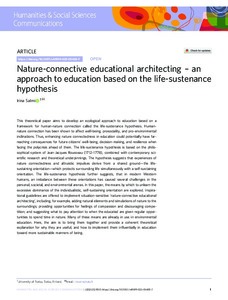Nature-connective educational architecting – an approach to education based on the life-sustenance hypothesis
Salmi, Irina
https://urn.fi/URN:NBN:fi-fe2025082791813
Tiivistelmä
This theoretical paper aims to develop an ecological approach to education based on a framework for human-nature connection called the life-sustenance hypothesis. Human-nature connection has been shown to affect well-being, prosociality, and pro-environmental inclinations. Thus, enhancing nature connectedness in education could potentially have far-reaching consequences for future citizens’ well-being, decision-making, and resilience when facing the polycrisis ahead of them. The life-sustenance hypothesis is based on the philosophical system of Jean-Jacques Rousseau (1712–1778), combined with contemporary scientific research and theoretical underpinnings. The hypothesis suggests that experiences of nature connectedness and altruistic impulses derive from a shared ground—the life-sustaining orientation—which protects surrounding life simultaneously with a self-sustaining orientation. The life-sustenance hypothesis further suggests, that in modern Western humans, an imbalance between these orientations has caused several challenges in the personal, societal, and environmental arenas. In this paper, the means by which to unlearn the excessive dominance of the individualistic, self-sustaining orientation are explored. Inspirational guidelines are offered to implement situation-sensitive ‘nature-connective educational architecting’, including, for example, adding natural elements and simulations of nature to the surroundings; providing opportunities for feelings of compassion and discouraging competition; and suggesting what to pay attention to when the educated are given regular opportunities to spend time in nature. Many of these means are already in use in environmental education. Here, the aim is to bring them together and provide a coherent theoretical explanation for why they are useful, and how to implement them influentially in education toward more sustainable manners of being.
Kokoelmat
- Rinnakkaistallenteet [27094]
